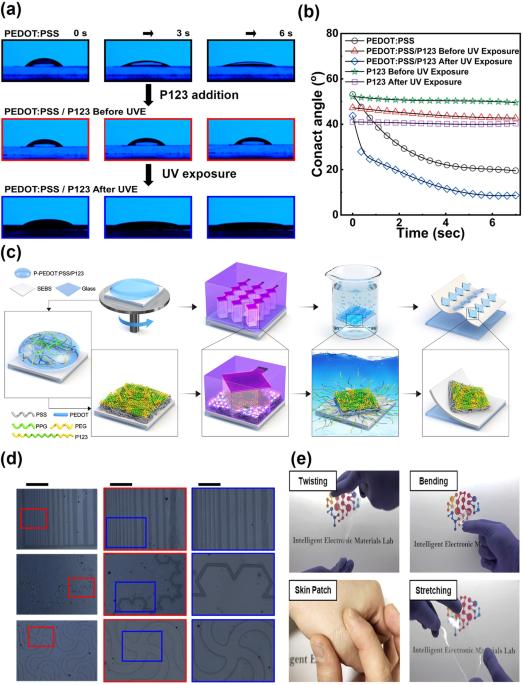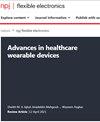Water-based direct photopatterning of stretchable PEDOT:PSS using amphiphilic block copolymers
IF 12.3
1区 材料科学
Q1 ENGINEERING, ELECTRICAL & ELECTRONIC
引用次数: 0
Abstract
The use of water-based chemistry in photolithography during semiconductor fabrication is desirable due to its cost-effectiveness and minimal environmental impact, especially considering the large scale of semiconductor production. Despite these benefits, limited research has reported successful demonstrations of water-based photopatterning, particularly for intrinsically water-soluble materials such as Poly(3,4-ethylenedioxythiophene):poly(styrene sulfonate) (PEDOT:PSS) due to significant challenges in achieving selective dissolution during the developing process. In this paper, we propose a method for the direct patterning of PEDOT:PSS in water by introducing an amphiphilic Poly(ethylene glycol)-block-poly(propylene glycol)-block-poly(ethylene glycol) (PEO-PPO-PEO, P123) block copolymer to the PEDOT:PSS film. The addition of the block copolymer enhances the stretchability of the composite film and reduces the hydrophilicity of the film surface, allowing for water absorption only after UV exposure through a photoinitiated reaction with benzophenone. We apply this technique to fabricate tactile and wearable biosensors, both of which benefit from the mechanical stretchability and transparency of PEDOT:PSS. Our method represents a promising solution for water-based photopatterning of hydrophilic materials, with potential for wider applications in semiconductor fabrication.

使用两亲性嵌段共聚物对可拉伸 PEDOT:PSS 进行水基直接光图案化
在半导体制造过程中使用水基化学光刻技术具有成本效益高、对环境影响小等优点,特别是考虑到半导体生产的大规模化,因此是非常理想的。尽管有这些优点,但由于在显影过程中实现选择性溶解的重大挑战,成功演示水基光刻的研究有限,特别是对于聚(3,4-亚乙二氧基噻吩):聚(苯乙烯磺酸)(PEDOT:PSS)等内在水溶性材料。在本文中,我们提出了一种在 PEDOT:PSS 薄膜中引入两亲性聚(乙二醇)-嵌段-聚(丙二醇)-嵌段-聚(乙二醇)(PEO-PPO-PEO,P123)嵌段共聚物,从而在水中直接图案化 PEDOT:PSS 的方法。嵌段共聚物的加入增强了复合薄膜的拉伸性,并降低了薄膜表面的亲水性,只有在紫外线照射下与二苯甲酮发生光引发反应后才能吸水。我们将这种技术应用于制造触觉和可穿戴生物传感器,这两种传感器都受益于 PEDOT:PSS 的机械伸展性和透明度。我们的方法为亲水性材料的水基光图案化提供了一种前景广阔的解决方案,有望在半导体制造领域得到更广泛的应用。
本文章由计算机程序翻译,如有差异,请以英文原文为准。
求助全文
约1分钟内获得全文
求助全文
来源期刊

npj Flexible Electronics
Multiple-
CiteScore
17.10
自引率
4.80%
发文量
91
审稿时长
6 weeks
期刊介绍:
npj Flexible Electronics is an online-only and open access journal, which publishes high-quality papers related to flexible electronic systems, including plastic electronics and emerging materials, new device design and fabrication technologies, and applications.
 求助内容:
求助内容: 应助结果提醒方式:
应助结果提醒方式:


